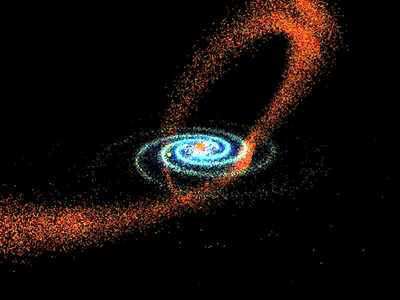As kids, many of us pondered what stars are made of.
孩提时代的我们大多都会思考星星到底是由什么做成的。
Some grown-up astronomers, on the other hand, wonder about where stars came from.
另一方面,一些已经成为天文学家,曾经的孩子则好奇星星们是从何而来。
Now, a study serves up a surprise.
而现在一项研究已经给出了令人吃惊的答案。
Because it seems that the smallest galaxies in the universe gave rise to an unexpectedly large proportion of stars.
因为结果显示宇宙中最小的星系产生了意想不到的大部分星星。
The findings are in the Astrophysical Journal.
这项研究已在《天体物理学杂志》上发表。

Most of the stars we see in the sky were formed when the universe was young, just a few billion years after the Big Bang.
我们看到的天上的大部分星星都是在宇宙年轻时形成的,也就是宇宙大爆炸过后的那几亿年里所发生的事。
So to study stellar origins, scientists use telescopes that allow them to see galaxies that are so far away, they're essentially looking back in time.
所以为了研究它们的起源,科学家们使用了天文望远镜观测到距离很远的星系,他们必须要追忆一下过往的岁月。
Previous observations had focused on the star-forming powers of larger galaxies.
之前的观测重点都是集中在更大星系中形成星星的能量。
But in this latest study, researchers used data collected by a powerful camera aboard the Hubble Space Telescope.
但是在最近的研究中,研究人员们使用了哈勃天文望远镜上安装的超级相机采集到的数据。
With this instrument, they could eyeball smaller, dwarf galaxies.
有了这个设备,研究者们便可以仔细观察较小的矮星系。
And they found that these diminutive dynamos churned out stars at a furious rate, fast enough to double their mass in only 150 million years.
而他们发现这些小型发电机以近乎疯狂的速度制造着星球,在只有一亿五千万年的时间里其质量就已翻倍。
That reproductive feat would take most so-called “normal” galaxies one to three billion years.
这样的高产率也许可以在未来1到3亿年时间里制造出更多的正常星系。
Seems the universe has long known what Danny Devito, Michael J. Fox and Dustin Hoffmann later proved:
莫非宇宙早已经洞察到Danny Devito, Michael J. Fox 和Dustin Hoffmann给世人所作出证明:
You don't have to be big to have real star power.
浓缩的精华力量无穷。


